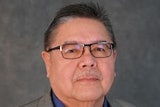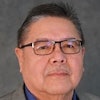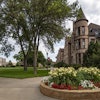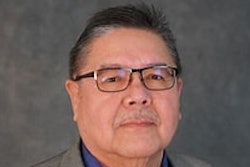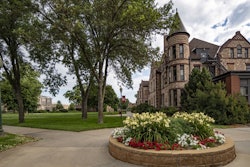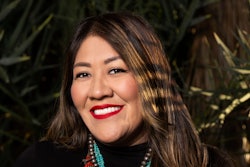At a recent conference of tribal colleges, participants were given a map of a campus parking lot. Not a map of how to get to the parking lot, but rather a map of the parking lot itself, revealing the spots with the strongest Wi-Fi signal.
Students, faculty and staff at Tribal Colleges and Universities (TCUs) across the nation have routinely converged on their local campus parking lots, with the glow of their laptops and cellphones as positive signs of connectivity.
TCUs have become experts at navigating slim resources, but even eighteen months into a pandemic that continues to wreak havoc on higher education, access to internet remain an obstacle for many of these institutions.
According to the Federal Communications Commission and the American Indian Higher Education Consortium, 68% of Americans living on rural tribal lands don’t have access to broadband. The average speed of internet at all 35 accredited TCUs is 336 megabytes per second. The average internet speed at a four-year institutions is 3.5 gigabytes per second. The costs of improving internet access or installing broadband at these schools are often higher because of their remoteness and a lack of internet service providers.
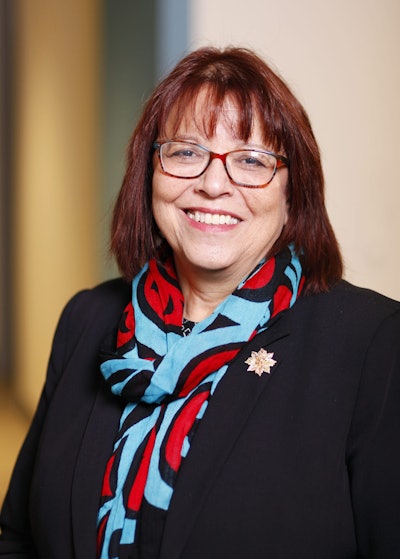 Cheryl Crazy Bull
Cheryl Crazy BullSince the CARES Act distributed funding, some TCUs have used the money to beef up their wireless connections. Others have opted instead to use those funds to incentivize vaccinations to allow for in-person instruction.
“On a scale of one to ten, it’s a ten,” said Dr. Cheryl Crazy Bull, president of the American Indian College Fund. “Having reliable access reduces the stress and anxiety that’s associated with being successful with your education. That’s really important. Access to tech is wrapped up in social and economic wellbeing,” she said, adding that a strong digital infrastructure “allows you to participate in society.”
Internet access, said Crazy Bull, could help TCUs in their mission, to not just provide a world-class education, but to actively preserve Native American cultures and traditions. “We’re all concerned about the loss of our tribal languages, and we know tech can be a resource for that restoration,” said Crazy Bull. “We think of it as being tied to tribal sovereignty. Tribal self-determination has to do with what information you have about yourself.”
Dr. Charles M. Roussel, president of Diné College in Tsaile, Arizona, said, eighteen months ago, the school had a combined bandwidth of about 400 megabytes a second per campus.
“Now we have 2.5 gigahertz per second,” he said. “So that’s a night and day difference.”
 Dr. Charles M. Roessel
Dr. Charles M. RoesselDiné has helped students access laptops and hot spots. They also opened two “micro-campuses” where students from any institution, K-12 or otherwise, can access campus facilities without having to travel far distances on a reservation that’s roughly 25 square miles wide. Diné even expanded their campus into Utah, a first for the college.
These infrastructural improvements cost roughly $1 million to complete. And their new, lightning quick internet speeds have added an additional $800,000 to the yearly internet bill. Roessel says that Diné has enough federal funding to sustain these improvements over the next few years, but he’s worried about what happens when that funding runs out.
“Without the additional money through the CARES Act, we would not be able to afford it.” he added.
Although under some of the worst circumstances, Roessel took advantage of the opportunity and funding available to “reimagine our system. We’re almost fully online. We can’t go back to the way things were.”
Dr. David Yarlott Jr., president of Little Big Horn College in Crow Agency, Montana, closed his school for three weeks in March 2020 while they figured out how to move online.
“We were totally an in-person-offering-courses institution,” which added the additional challenge of needing to get faculty certified to teach online, said Yarlott.
Little Big Horn was lucky—a faculty member who lived over three hours away had learned how to instruct her classes online during the winter months when travel was impeded by snow and ice. She helped the institution get comfortable with the uncomfortable.
“There were a few tech-savvy folks who were able to make adjustments. I wasn’t one of them,” Yarlott confessed with a chuckle.
Little Big Horn also offered laptops and hot spots to students. But the housing shortage on many reservations often complicates matters. Families often live together in multiple generation households, which can become a problem when siblings or parents try to share one wireless signal.
 Dr. David Yarlott Jr.
Dr. David Yarlott Jr.“The intent of the hot spot is for homework, but if other family members hop on, they bog down the strength of the broadband and it isn’t conducive to work on academics,” said Yarlott.
Chief Dull Knife College on the Cheyenne Reservation in Lame Deer, Montana, found the struggle for online access and capabilities to be such trouble that, by January 2021, Chief Dull Knife’s faculty and staff were determined to get all their students back into the classroom. They installed safety measures like plexiglass dividers and had a virtual inspection with the Center for Disease Control and Prevention to get approval to move back to in-person learning.
“We recognized that distance learning is not the way our students function,” said William Briggs, the dean of academic affairs at Chief Dull Knife. “It’s a very relational process here, and that relationship is voided when you get online. No matter how hard you try, you can’t make a personal connection with that screen in front of you.”
Chief Dull Knife decided to offer its students an incentive of $250 if they get vaccinated. Once they present their vaccination card, the institution writes a check that comes directly out of their CARES act funding. Many students use this money for food or gas. Some have used the funds to pay off electricity bills. So far, about 90% of the campus has been vaccinated, and there are no recorded cases of COVID-19 on campus since they returned to classrooms in spring of this year.
“When we did open up the students were quite thankful for it, because we are a safe place,” said Briggs.
Should the worst arise again, and a variant arrives which forces a return to a fully virtual world, Briggs said they have the supplies they need to make that transition, but added, “we really don’t want to.”
Liann Herder can be reached at [email protected].
